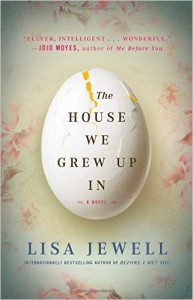The Blog
In most novels, characters have a problem to solve, a quest to fulfill, or a challenge to overcome. Pursuing this goal drives the novel forward. So when we read novels, we expect to have this problem, quest, or challenge set up early in the book, often in the first chapter. But there are other ways to create novels, as I was sharply reminded by Lisa Jewell’s The House We Grew Up In.
 I wasn’t familiar with Lisa Jewell’s writing until I won this novel in a giveaway from She Reads Book Club. Jewell is a British author with 10 previous novels. As soon as The House We Grew Up In made its way to the top of my to-read pile, I plunged in. And here’s what I found. The characters in this novel don’t have a central problem, quest, or challenge—at least not one that they can define. What they have is a tragedy. Rhys, one of twins who are the youngest children in the Bird family, hangs himself from the beams in his bedroom when he is 16 years old.
I wasn’t familiar with Lisa Jewell’s writing until I won this novel in a giveaway from She Reads Book Club. Jewell is a British author with 10 previous novels. As soon as The House We Grew Up In made its way to the top of my to-read pile, I plunged in. And here’s what I found. The characters in this novel don’t have a central problem, quest, or challenge—at least not one that they can define. What they have is a tragedy. Rhys, one of twins who are the youngest children in the Bird family, hangs himself from the beams in his bedroom when he is 16 years old.
From the day of Rhys’s suicide (Easter Sunday 1991), the lives of the other Bird family members become twisted, contorted, reshaped in ways they never imagined possible. This marvelous character development is where Jewell’s skill as a writer shines most brilliantly. Each member of the family is drawn so vividly that he or she could walk right off the page.
Lorelei, Rhy’s mother, is the most colorful character in every way. She even describes herself as colorful—she likes to wear colorful clothes and decorate with bright colors in her home. She’s whimsical, sparkly, and a leader in fun and games. What she doesn’t say when she describes herself is that she stockpiles boxes of everyday items like insect repellent. She also refuses to throw away anything, especially her children’s old possessions. After Rhys’s death, the stockpiling and collecting become an obsession.
Megan, Rhys’s oldest sibling, is the opposite of Lorelei. Megan is neat and organized. She’s a natural minimalist who thinks keeping her life simple will keep it manageable and predictable, but she’s wrong.
Bethan, Rhys’s next oldest sister, if she ever thought to describe herself, would say she was unattractive, Megan’s mousy younger sister. She tells herself her impractical mother needs her at home, and so she continues to live in her mother’s house well beyond the age when young adults need to be on their own. And she looks to the family for all her joy in life, even in places where she shouldn’t look.
Rory, Rhys’s twin, is the family’s golden boy—smart, attractive, popular in school. So no one understands when he falls in love with weird Kayleigh and goes to live with her in a commune in Spain.
Colin, Rhys’s father, appears to be the most stable member of the family. He’s steadfast through Rhys’s death. He’s accepting when Lorelei invites her Lesbian lover to live with her and moves Colin to an apartment in their house. He reaches out to Kayleigh and the baby she has with Rory when Rory abandons them. But eventually he wants more from life and finds it in an unexpected place.
These people are not trying to solve a mystery. Some of them think they know why Rhys killed himself, but there’s no way to be sure. As I said before, they have no looming obstacle before them. They’re trying to get on with their lives, to deal with the blame they feel for each other and for themselves. Colin says, “Maybe if there’d been an explanation we could all have moved on. Found closure. But there wasn’t and we didn’t and we’ve all gone off on tangents—”
As they explore their tangents, the wandering paths that Jewell creates for them, we readers learn along with them what family loyalty and courage can truly mean.
Tags: Lisa Jewell, novels, reviews
Get in Touch
Follow on Facebook
Follow on Twitter
___________________________________________________
Website Design by Eliza Whitney
 Posts from Late Last Night Books
Posts from Late Last Night Books



